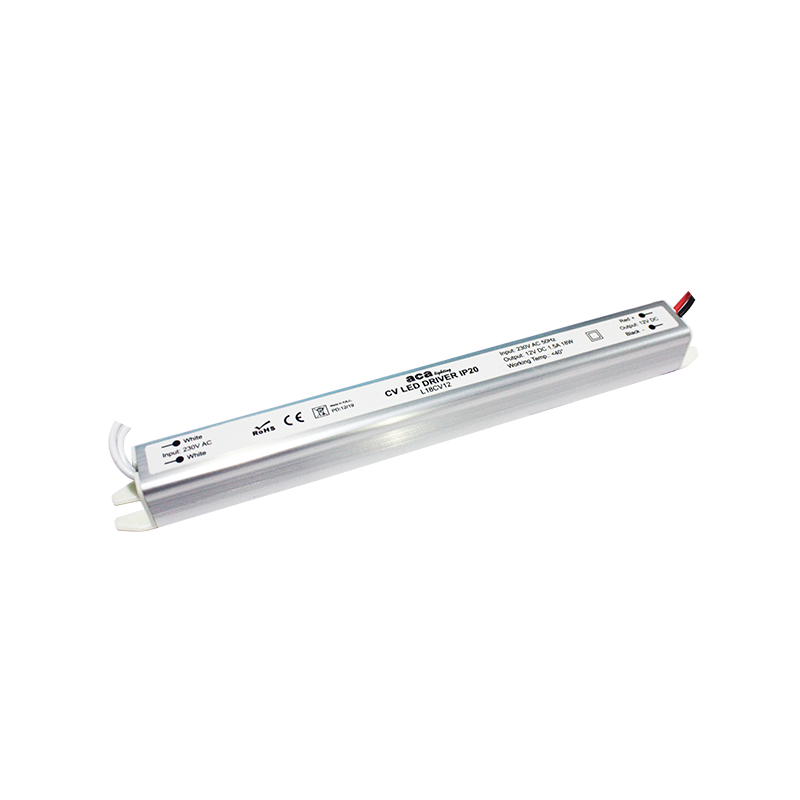LINEAR METAL CV LED DRIVER 18W to 72W 230V AC-12V DC 1.5A IP20 With Wire
400.00 ₨ – 980.00 ₨Price range: 400.00 ₨ through 980.00 ₨


### 18W LED Driver Description
An **18W LED driver** is an essential component in powering and regulating the electrical output of an **18-watt LED** light source. LED drivers are devices that provide the necessary voltage and current to ensure LEDs operate efficiently and safely. Since LEDs are highly sensitive to electrical variations, an LED driver is crucial in maintaining the integrity and longevity of the LED lights.
#### Key Features and Functionality:
1. **Power Output**:
* The **18W LED driver** is designed to provide a consistent output power of 18 watts to the LED fixture. This ensures that the LED operates at its optimal brightness and efficiency. The wattage refers to the power consumption of the LED light, and the driver must be able to handle this load without overheating or causing electrical damage.
2. **Constant Current or Constant Voltage**:
* LED drivers come in two primary types: constant current and constant voltage.
* **Constant Current Drivers** are used when LEDs require a specific current to operate. The driver maintains a constant current and adjusts the voltage as needed depending on the LED’s characteristics.
* **Constant Voltage Drivers** are used when LEDs are designed to operate at a fixed voltage (e.g., 12V The driver regulates the voltage to ensure the LED gets a steady supply.
* An 18W LED driver will generally be a constant current driver, but it depends on the LED setup. For example, a 12V LED system would use a constant voltage driver with a specific power output of 18W.
3. **Voltage and Current Regulation**:
* LEDs require stable and controlled voltage and current to avoid flickering, overheating, or failure. The LED driver regulates the voltage and current by converting incoming electrical energy (AC or DC) into the proper output for the LEDs.
* The 18W LED driver typically adjusts the current to match the load and ensures that the output power does not exceed the maximum wattage rating (18W) to prevent damage to the LED lights.
4. **Input and Output Specifications**:
* **Input Voltage**: The input voltage typically ranges between 100V to 277V AC (in most regions), which corresponds to the common mains voltage. Some models may be rated for DC input as well.
* **Output Voltage and Current**: The output voltage can vary, often in the range of 12V to 24V DC for most LED systems. The output current is typically between 350mA to 700mA, depending on the LED’s requirements.
5. **Efficiency and Heat Management**:
* LED drivers are designed to be energy-efficient, converting the input electrical power into usable energy for the LED light with minimal loss. High-efficiency drivers help to reduce electricity consumption, making them cost-effective over time.
* Thermal management is also a critical feature of the driver. Most 18W LED drivers incorporate heat sinks or advanced cooling techniques to dissipate excess heat generated during operation. Efficient heat dissipation helps maintain the driver’s longevity and performance.
6. **Protection Features**:
* To ensure the safety and longevity of both the LED driver and the LED fixture, these drivers often include a variety of protection mechanisms:
* **Overcurrent Protection**: Prevents excess current from damaging the LED and driver.
* **Overvoltage Protection**: Protects the LED from voltage spikes or fluctuations.
* **Short-Circuit Protection**: Safeguards against electrical faults that could result in short circuits.
* **Thermal Protection**: Automatically reduces output or shuts down the driver in case of excessive heat buildup.
* **Surge Protection**: Protects against voltage surges, often caused by lightning or power grid fluctuations.
7. **Applications**:
* The **18W LED driver** is suitable for a wide range of applications, including residential, commercial, and industrial lighting. Common uses include:
* **Indoor lighting**: Ceiling lights, downlights, track lighting, and spotlights.
* **Outdoor lighting**: Garden lights, streetlights, and signage.
* **Accent and decorative lighting**: For creating ambiance or highlighting architectural features.
8. **Compact and Versatile Design**:
* One of the significant advantages of the 18W LED driver is its compact size. LED drivers are often smaller than traditional lighting ballasts, which makes them easier to install in confined spaces. Some models are even designed to be waterproof or weather-resistant for outdoor installations.
9. **Dimmable Features**:
* Many 18W LED drivers are designed to be compatible with dimming systems, allowing users to adjust the light intensity according to preference. Dimming also helps to save energy, extend the lifespan of the LED, and create different lighting effects.
| Selection | 18w, 24W, 36W, 48W, 60W, 72W |
|---|
Related products
Arduino interface Module
Arduino interface Module
3.7V 3A LI-ION LITHIUM BATTERY 18650 CHARGER OVER CHARGE PROTECTION BOARD
Arduino interface Module
Arduino interface Module
AC Motor Speed Controller 2000W SCR Adjustable Voltage Regulator
Arduino interface Module
Micro SD Card TF Card Module SPI Interface for Arduino, PIC, AVR, ARM
Arduino interface Module
Arduino interface Module



























